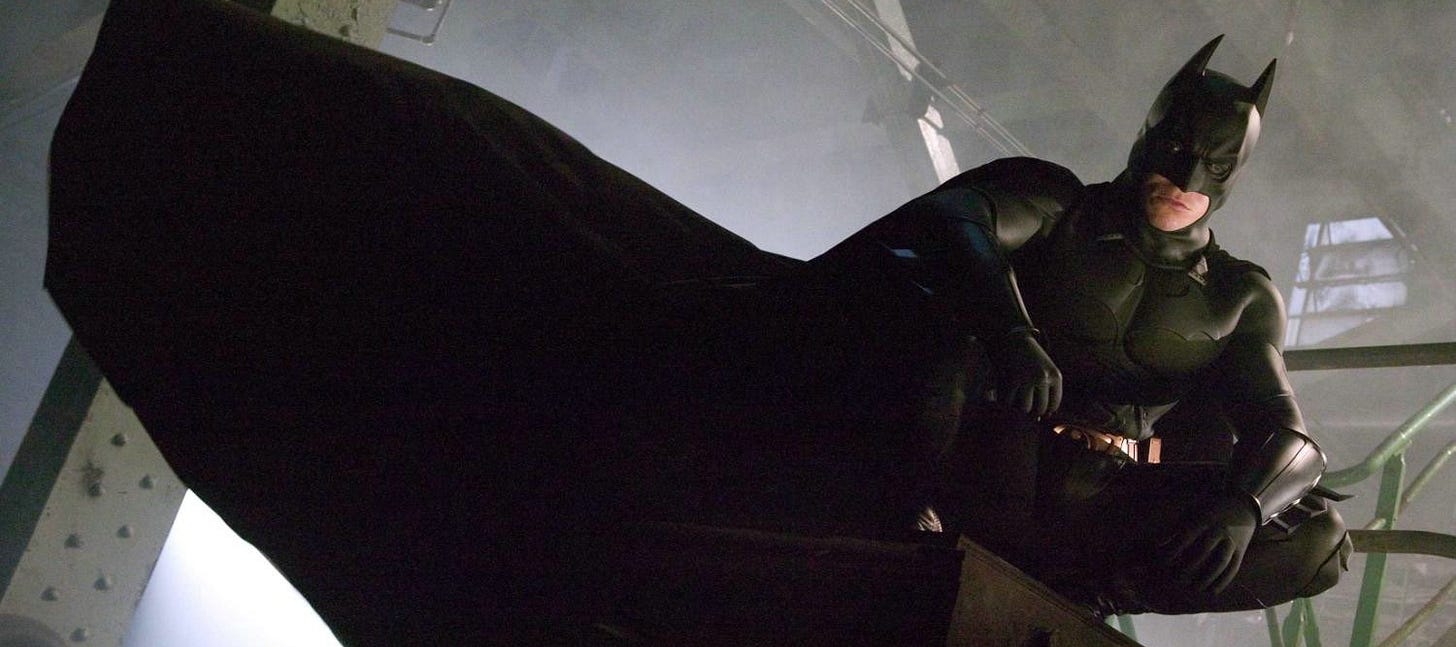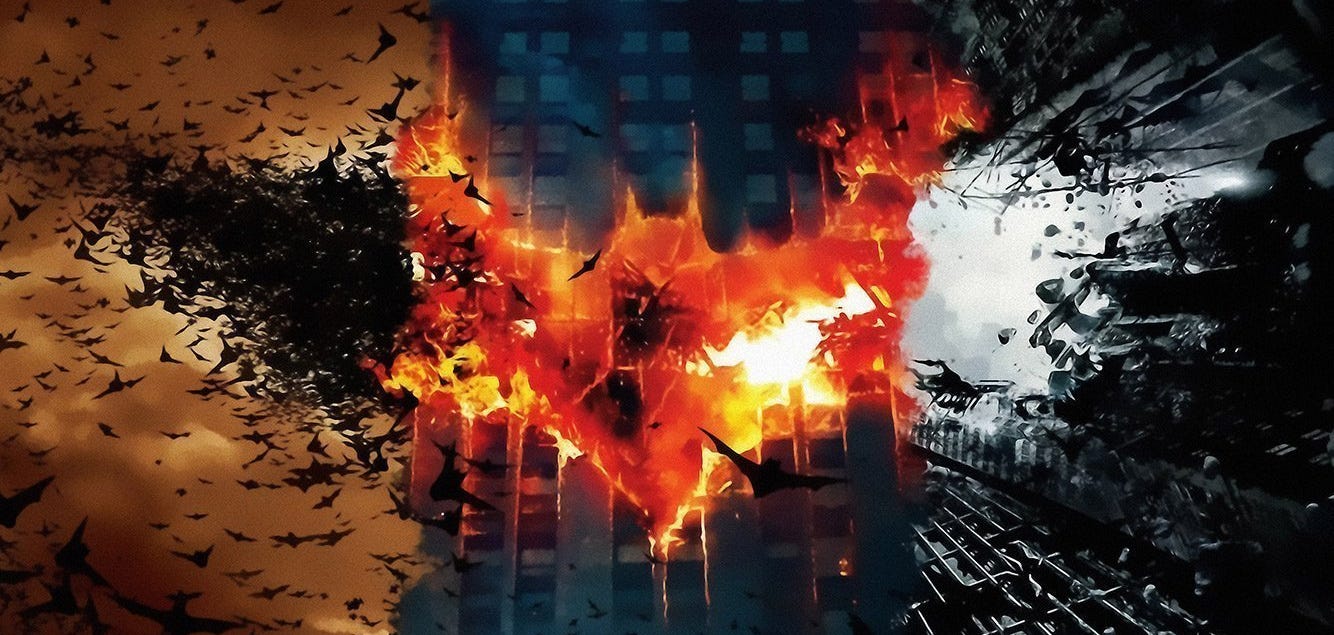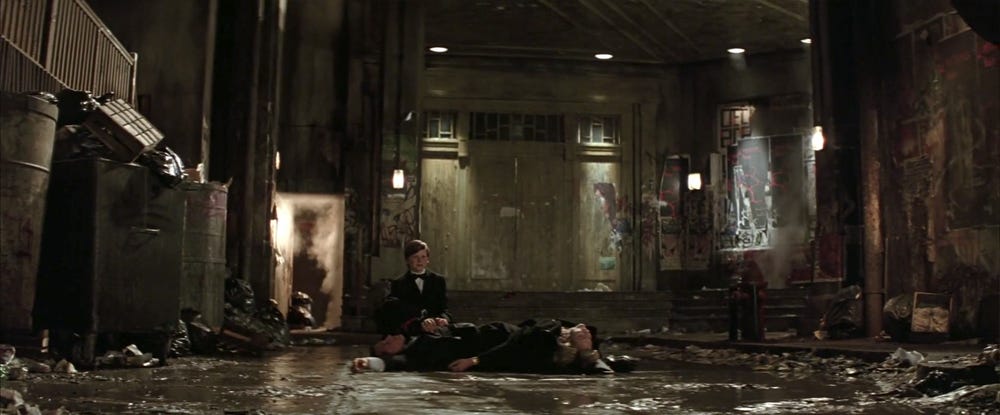Christopher Nolan's Batman - Background
Swoosh, swoosh, swoosh, swoosh. These four innocuous sounds wouldn’t ordinarily interest a person; but to me, those sounds define the rustle of a cape in the wind, the long, black, winged cape of the dark knight himself – Batman. The character of Batman/Bruce Wayne was never of any particular interest to me until one film, The Dark Knight, completely changed my view on the character, and on superhero films as a whole. I find the character of Batman that is portrayed in Christopher Nolan’s Dark Knight trilogy to be the most sophisticated, relatable, and resilient superhero character of all time.
Much like the citizens of Gotham have varying views on Batman, Batman’s actions in the films have received varying views from critics and scholars. Some writers call this portrayal of Batman “a driven vigilante with a thirst for power,” while others liken him to a Christ-like figure (Gilmer 2013). Abel Parker makes the latter comparison, writing, “The Dark Knight trilogy is the complete story of, well, a Dark Knight, [covering] his birth, death, and resurrection” (ebook).
Regardless of one’s perception of the character, the critical and financial successes of the Dark Knight trilogy are proof of its legacy; it is a series known for “thoroughly reenergizing and reimagining the superhero genre” (Jesser 2012). I would argue that the success of the films lies in the incredible portrayal of Batman, brought about by the depth of Batman’s character in the series. The emergence and evolution of the Batman is the focal point of the Dark Knight trilogy, and the elements of the story each contribute to the furtherance of the epic story of Bruce Wayne and the Batman.
Biographical Sketch
Batman’s background is found in the life of his alter ego, Bruce Wayne. Bruce Wayne was born on October 13, 1975 to the wealthiest family in Gotham, the Waynes. His father, Thomas Wayne, was a doctor, military defense developer, and well-known philanthropist, giving to the poor and even building a monorail system to provide a cheap method of transportation in the city. His mother, Martha Wayne, was an Irish debutante, and a Catholic (Bruce Wayne [Nolanverse]). Bruce’s parents were murdered when he was eight years old (to be discussed later), and his butler, Alfred Pennyworth, became his legal guardian. At the age of four, Bruce developed a close friendship with Rachel Dawes that would last well into their adult lives and eventually develop into romantic feelings (Bruce Wayne [Nolanverse]).
When he was eight, Bruce fell into a dry well and was attacked by a swarm of bats, causing a deep-seated fear of bats for years to come. This fear is what later caused Bruce to choose the identity of his alias, Batman. When Alfred asks him why he chose bats, he responds by saying, “Bats frighten me. It’s time my enemies shared my dread” (Thomas & Nolan, 2005). Not long after falling in the well, Bruce was attending an opera with his family and asked them to leave early after being scared of a scene containing bats. As they left the theater, the parents were mugged and killed. Bruce feels responsible for his parents’ deaths, and carries this guilt for years to come. Little is known about Bruce’s adolescence, but when he reached his twenties, he “traveled the world to understand the criminal mind and master its secrets” (Thomas & Nolan, 2005). He eventually trained with an elite vigilante group, the League of Shadows; after disagreeing with their morals, he took these skills back to Gotham, seeking to break the corrupt system that had overtaken the city.
Bruce’s personality and character traits contain both strengths and weaknesses. He is compassionate, a trait recognized by the leader of the League of Shadows, Ra’s al Ghul. “Your compassion is a weakness your enemies will not share,” says al Ghul, to which Bruce responds, “That’s why it’s so important. It’s what separates us from them” (Thomas & Nolan 2005). This compassion proves to be key in his drive to protect the people of Gotham, and in his belief in the innate goodness of humanity. He also displays selflessness, a key strength in his battle against corruption. He is constantly acting in the interest of others and always puts his life on the line to save the citizens of Gotham. This selflessness is fully displayed when he takes the blame for another man’s crimes so that the city could still look up to that man as a hero.
Bruce reasoned, “Sometimes the truth isn’t good enough. Sometimes people deserve more. Sometimes people deserve to have their faith rewarded” (Thomas & Nolan 2008).
Because of his actions as a vigilante, much of Bruce’s life is built around a lie (also reflected in his belief that “the truth isn’t good enough), which provides many limitations as both Batman and as Bruce Wayne. Bruce puts on a facade for the public eye, pretending to be a careless playboy and reckless drunk, partying all day and night. After years of helping Bruce lie and scheme, Alfred implores him to give up all the lies, saying, “Maybe it’s time we all stop trying to outsmart the truth and let it have its day” (Thomas & Nolan 2012).

When acting as Batman, he is limited by his lack of superpowers, as is acknowledged by Ra’s al Ghul: “You are just an ordinary man in a cape! That’s why you couldn’t fight injustice” (Thomas & Nolan 2005). Another major limitation he experiences is his conviction to never kill. This belief is divisive and causes Bruce to leave the League of Shadows. Several years later, an adversary called the Joker, exploits this limitation and uses it in his plan to wreak havoc on Gotham. The Joker takes advantage of Bruce’s “one rule” in several of their encounters, and it nearly costs Bruce the victory. Despite this, Bruce is always able to maintain his stance that “[he’s] no executioner,” and he never directly kills a person (Thomas & Nolan 2005). While this conviction may have limited him in his battles against dangerous criminals, it is what separated him from being a villain, and it proves to be one of his greatest strengths. Batman is a romantic hero – he is rejected by society (even hunted down after The Dark Knight), but his compassion for his cause, saving Gotham, is abundant.
Bruce is motivated by his desire to create change in his city. This is why he became Batman, telling Alfred:
“People need dramatic examples to shake them out of apathy, and I can’t do that as Bruce Wayne. As a man, I’m flesh and blood, I can be ignored, I can be destroyed, but as a symbol…as a symbol I can be incorruptible. I can be everlasting” (Thomas & Nolan 2005).
He truly achieves his goal as a symbol, with even his enemies acknowledging his impact on Gotham. “You truly are incorruptible,” said the Joker after Batman captured him (Thomas & Nolan 2008). While this symbol has made the Batman of the Dark Knight trilogy a legend, the writing, acting, and scoring in the films contributed to creating the symbol of justice and hope that many know and admire to this day.



